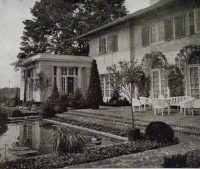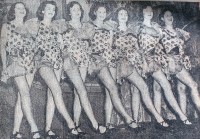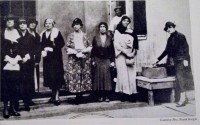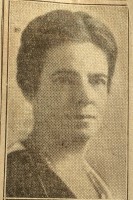Celebrating the 100-Year History of the Woman’s Club of White Plains Part 2 – The 1930’s

By Colleen Fay – The 1930’s were a stressful time in the United States The country was in the throes of the worst depression it had ever encountered. In spite of that, the Contemporary Club (former name of the Woman’s Club of White Plains) continued to grow and was able to support its community in many ways.
At the end of the 1920’s, the club had purchased a lot on Hartsdale Avenue and plans were underway to build the new clubhouse on this property. However, the CV Rich Mansion on Ridgeway suddenly became available and the club decided to purchase the house. Real estate prices had continued to climb and the Hartsdale Avenue property was eventually sold for a substantial profit. The Club had almost $71,000 on hand due to fund-raising efforts as well real estate sales. They had a stroke of luck when, two months before the mortgage company holding all the money went bankrupt, the Club cashed out its holdings. With the $71,000 in the building fund and a mortgage of $62,000, the house, garage and 4 acres were purchased from the C.V. Rich family for $87,000. Plans for the immediate addition of an auditorium were part of the purchase.
In October 1931, an open house was held to display the new clubhouse to the community. Over 1000 members and guests toured the house during the afternoon and evening. Today all of the mantels, sconces, and the end irons in the library are original to the house. The fireplace mantel in the tearoom is made of Carrera Marble and is similar in design to one in the Doge’s place in Venice. The fountain in the Tea Room, also of Carrera marble, once worked and held gold fish. The paintings in the dining room are believed to be from the 1800’s.

Almost immediately after the purchase, construction of the new auditorium began. The cornerstone was laid by Mrs. Lillian Cheney in October 1932 and the auditorium was finished in December 1933. Although the cost of construction was substantial, the women were savvy enough to recognize the potential income from rentals of the facility plus they needed somewhere to put the club members, which by 1938 was nearly 700. More importantly, at a time when so many men were unemployed, this project brought a number of welcome jobs to the area. In fact, the Contemporary Club received a letter from President Hoover’s staff encouraging the Club to build the auditorium for this reason.
The Contemporary Club helped out during the Depression in other ways as well. It founded the Women’s Exchange to help women whose incomes had been drastically diminished due to the Depression. Women brought baked goods to sell and earn extra money. It was located on Church St. The Nature and Study Group had a Farmer’s Market for the sale of locally grown vegetables. In addition, members raised and donated $100 to the Emergency Relief Fund and $1200 to the Unemployment Relief Fund.
The Club membership was growing and changing. Originally, there was only the Active or Daytime section. In 1930, Junior (women aged 21 to 35) and Sub-Junior (teenager) sections were added. In 1932, the Business and Professional Women’s Group, calling themselves the Soiree, began meeting at the club twice a month. In 1935, they were incorporated into the Club as the Evening section.

There were always numerous social and entertainment activities at the Club. In 1934, Hollywood actor Ernest Truex rented the auditorium for Summer Theater, a tradition that continued for many years. Numerous plays were performed in the auditorium especially in the summer months to huge audiences. During intermissions, patrons often went outside to the back yard. Apparently there was some concern that someone might fall into the lily pond. Fashion Show luncheons, featuring Club members as models, were also popular as were flower shows, bridges, art shows and lectures on a wide variety of social and political issues. These programs, plays and social events were so popular that the club considered buying adjacent property for additional parking space as there was often a problem accommodating cars for various functions. Back in the 30’s, it would not have been unusual for 500-600 people to be in the auditorium for an event.
In 1935 the Treble Clef was formed. This was a chorus consisting of club members led by a professional conductor who was also a member, Antonia Brico. (She was the first woman to conduct the New York Philharmonic.) The Treble Clef sang at various locations including multiple performances at Carnegie Hall.

The Contemporary Club was also very civic minded. They sponsored an evening program on the local radio station, WFAS, discussing various humanitarian and educational topics of interest to the community. Club members and invited speakers participated. One member, Miss Ruth Taylor (for which the Ruth Taylor Nursing Home is named) spoke on social issues. Miss Taylor was the Commissioner of Public Health in Westchester County for over 40 years. The Club pressured city officials to restore back door garbage collection, eliminating unsightly garbage from the streets. In the late 1930’s, the Club decided to form its own committee to investigate the problem of slum housing and its proposed demolition. This was a hot issue in White Plains at the time. The White Plains Common Council had been considering a commission to investigate this but club members felt they needed to investigate on their own. Numerous lectures on the current state of the prison system were sponsored. In 1939 the clubhouse was offered as shelter for catastrophe or emergency.
The Legal Aid Society was formed in 1933 and the Woman’s Club was a key proponent of this They even donated $500 to the cause. To put that in perspective, in 1933 a new Plymouth cost $450, gas was 10 cents/gallon and the average worker made $20/week.
Other charitable ventures centered on the Thrift Shop which club members contributed to and staffed. Numerous bridges were held to raise money for various causes. In 1936 the Christmas Doll Project was started. Club members would restore and dress an expensive doll that had been damaged. The doll would then be sold in the Thrift Shop for a fraction of its value. This tradition continued for over 20 years. Other toys were also collected and sold at the Thrift Shop.
Back then, the Contemporary Club received extensive coverage in the local press. There were frequent articles about Club activities, elections of new officers, what the Junior section was doing. There was even a section devoted to weekly Club events. Beginning in 1937, a column called “Contemporaries” and written by a Club member appeared in the local paper several times a week. This column continued for several years.
Club Dial, the monthly magazine, continued to be an important part of the Club’s livelihood. By the end of the decade, Club Dial had made over $50,000 in profit which was used to support the upkeep of the CV Rich Mansion (which was and still is quite expensive) as well as local charities.
By the end of the 1930’s, the Contemporary Club was alive and thriving. However, the effects of the Great Depression were still being felt and the world was teetering on the brink of another World War. These would present both new and old challenges in the next decade.
This article is part of a series published by the Woman’s Club of White Plains in their newsletter Club Dial and reprinted in The White Plains Examiner (WPE). Part 1– Origins and Early Days, 1910’s and 1920’s was published in WPE on Feb. 23, 2016 and may also be found at theexaminernews.com.

Examiner Media – Keeping you informed with professionally-reported local news, features, and sports coverage.
